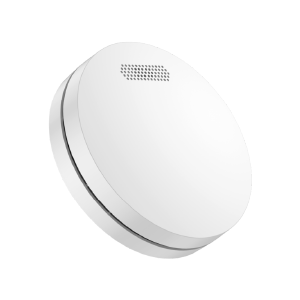From February 2022, it will be against the law to reside in a home without an interlinked fire alarm system. This guide will provide you with all the necessary information to make sure your home is compliant.
Why The Laws Were Changed
Before we get into the finer details of these new rules it must be acknowledged that, to many, these changes may be inconvenient.
However, the disturbing scenes witnessed at the Grenfell Tower blaze only a short while ago illuminated an inconvenient truth; the dreadful standards of fire protection weren't just limited to that one building. A 2018 study found that 38% of homes in the UK don't even have a working smoke alarm to alert residents (and their neighbours) of a fire.
Of course, it's easy to disregard statistics; few people believe they will be affected themselves. Yet, every year over 10,000 homes are destroyed and hundreds of people die because their homes are ill-equipped.
To address this problem, the Scottish Government made the decision to apply sweeping changes to fire alarm legislation. Not only would every home need to be equipped with a fire alarm system, these devices needed to work together.
With multiple alarms triggering, warning signs would not be missed and fire could be extinguished quicker resulting in reduced damage and fewer deaths. Although this move would have been a huge step forward, the COVID-19 pandemic created an enormous setback to these plans.
The deadline was pushed back to February 2022 and the threat remained present. The rest of this guide will focus on helping you to reduce risks in your home and get compliant with that new legislation.
Types Of Alarm
There are three different types of alarm that you need to know about:
- Smoke alarms
- Heat alarms
- Carbon monoxide detectors
We'll now cover the difference between each of these and clarify what situations you need them.
The Difference Between Smoke & Heat Alarms
Although smoke and heat alarms are both used to detect the presence of fire, they are suited to different areas of your home. Smoke alarms are more sensitive to particles and, therefore, are quicker to detect and trigger upon signs of fire. However, if they are placed in an area (such as the kitchen) that is more prone to smoke then you'll get false alarms. Instead, by using a heat alarm in your kitchen to trigger when a rapid increase in temperature occurs you'll still be protected without having to constantly turn off false alarms.
Where Should The Alarms Be Placed?
From a safety point of view, an alarm should really be installed anywhere in your home that there is a risk of fire. Although the kitchen is the highest risk area, few people realise the hazards in other rooms. For example, multi-plug adapters are often used in living rooms and if they become faulty they could start a fire. Likewise, many people use candles in their bedroom to relax and all it takes is a small mistake and you could have a serious problem on your hands.
The government legislation states that at the very least you need a smoke alarm in your living room and your hallway and a heat alarm in your kitchen.
Do I Need A Carbon Monoxide Detector?
A carbon monoxide leak cannot be smelled, tasted or felt. Yet prolonged exposure will result in symptoms ranging from fever to death. Thus, a carbon monoxide detector is the best way of protecting yourself and your loved ones against this silent killer.
Legally, every home must have a carbon monoxide detector in any room where there is a fuel-burning appliance.
The most common appliances you need to be aware of are:
- Your boiler
- And your living room fireplace (wood, pellet or gas powered).
Most people in Scotland have their boiler in the kitchen and only need one carbon monoxide detector. However, if your boiler is in a different room then you need to buy an additional device for that room.

How Will The New Regulations Impact Your Home Insurance?
Compliance with the new standard will form part of any Home Report and it might be introduced as a requirement by home insurance companies. Different insurance policies provided by different insurers will have varying terms and conditions which you will have to comply with to not invalidate your insurance.
Anyone who is unclear about their terms and conditions regarding fire and smoke alarm requirements should get in touch with their home insurers. While local authorities will be able to use their statutory powers to require owners to carry out work on substandard housing, they advise it to comply with the government standard as soon as possible and contact their insurer for updated terms and conditions.
Examples
Here are some case studies to compare against your own home so you can better understand how many fire detectors you might need:
Two-Bedroom Apartment
Billy and Lauren live in a two-bedroom apartment with a kitchen, living room and bathroom. Their boiler is located in the kitchen. Their oven is electric powered and they spend most of their time in the living room. Here is what they would need to get above board:
- One smoke alarm installed in the living room
- One smoke alarm installed in the hallway
- One heat alarm installed in the kitchen
- One carbon monoxide detector installed in the kitchen
Three-Bedroom Detached House
John, Margaret and their two children live in a three-bedroom detached house with a kitchen, two living rooms (one has a gas-powered heater and the other uses radiators to stay warm). They also have a dining room, a bathroom and a study. Their boiler is located in one of the children's bedrooms.
Here's what they would need to comply:
- One smoke alarm installed in each living room
- One carbon monoxide detector installed in the living room with the gas-powered heater
- One smoke alarm installed in the hallway
- One heat alarm installed in the kitchen
- One carbon monoxide detector installed in the bedroom where the boiler is located
The Difference Between Wired & Wireless Alarms
While the regulations allow for both hard-wired and wireless alarm systems, there are a few things you should consider before making a purchase.
1. Installation
Hard-wired fire alarm systems require a significant investment to install. You need to hire an experienced electrician to connect the detectors to your power supply and run cables around your home. Then, there's the added expense of having to re-paint for ceiling markings left over.
On the other hand, the wireless fire alarms do not require any expertise and take just a couple of minutes to connect and mount.
2. Maintenance
Another drawback of the wired alarm systems is the continued maintenance fees. Once a year, an electrician must be called out to check that no wires have become dislodged and that they all still work together.
In contrast, checking a wireless alarm system can be done in seconds. Just by pressing the test button on one of the alarms, they will all sound together, letting you know they are active.
3. Adding Extra Units
If you decide to expand your fire alarm system and install extra units in other rooms with a wired system, you will need an electrician's help
With wireless interlinked smoke alarms, new devices can easily be paired and will not disrupt your existing set up.
What To Consider When Buying A Fire Alarm System
Minimum Battery Life
Before the new regulations kicked in, it was acceptable for fire alarm systems to have removable batteries and a 1-year lifespan. Now though, you need to make sure the battery lasts at least 10 years and cannot be tampered with in order to comply.
They Must Be Able To Interlink
It's vital that your smoke and heat alarms are able to link together to make sure your home is compliant. For that reason, it is recommended that you buy your smoke and heat alarms from the same brand so you know for sure they are able to link together.
Easier Installation Is Better
Choosing a system that is easy to install will lead to considerably fewer headaches (both in the short run and long). As mentioned previously, wired systems are notoriously expensive and have no real tangible benefits in comparison to wireless options.
If you're not a fan of DIY, it's recommended that you avoid drilling and screwing. Instead, opt for strong adhesive stickers to fit the alarms which only take minutes to install. You can check our guide on how to install fire alarms by yourself.












Thank you so much - the other pieces of information I read were so confusing and this has helped me understand it!
I found the visual guide on your website very helpful and ordered the standard bundle for the required protection. The detectors seem very easy to install, I'm not an ace with DIY
how is it possible that 38% of the houses don't have a working fire alarm??? I installed the interlinked alarms as soon as I found out how they work, not because of the law, but because they are safe! if anything happens in the kids' room, I will be alerted wherever I am in the house! this new law should have a shorter deadline. I hope they will be checking all households
Very helpful! Thanks! I shared this article with my daughter
I seen this on the tv but it wasn't clear on how to proceed. Thank you for the advice, I realised that I won't be spending a fortune again.
I installed the interlinked alarms recently following the legislation update. It took me 20 minutes to install them in every room! When we first moved into our current house two electricians spent hours just wiring all the alarms. I'm very happy that this legislation made it easy
Thank you for your information, it is clear, and concise.
will be doing some more research.
I was looking for smoke and heat alarms and an internet search found Fireguard+ for me.
I bought the basic pack and after delivery quickly had the alarms linked and working.
The Fireguard bundle we ordered is perfect both for compliance with the law and aesthetics in the house. The customer service is excellent, with queries promptly addressed in a courteous and informative manner. Very satisfied.
Ordered Monday received Friday 11.30 fitted by 12.30. No hassle easy to install great service
I have a wired (with battery backup) system which would have required an additional Heat detector installed in the kitchen ceiling. Purchase of that, an RF base and an RF base for an existing detector PLUS the power supply for the heat detector - was the same cost, but way more hassle. The battery solution is much neater, and both options would require new heads in 10yrs time.